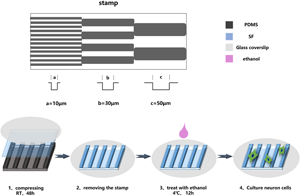Crossref Citations
This article has been cited by the following publications. This list is generated based on data provided by
Crossref.
Wu, Yu
Wang, Meijian
Wang, Yong
Yang, Huiran
Qi, Hao
Seicol, Benjamin J.
Xie, Ruili
and
Guo, Liang
2020.
A neuronal wiring platform through microridges for rationally engineered neural circuits.
APL Bioengineering,
Vol. 4,
Issue. 4,
Yonesi, Mahdi
Garcia-Nieto, Mario
Guinea, Gustavo V.
Panetsos, Fivos
Pérez-Rigueiro, José
and
González-Nieto, Daniel
2021.
Silk Fibroin: An Ancient Material for Repairing the Injured Nervous System.
Pharmaceutics,
Vol. 13,
Issue. 3,
p.
429.
Mikhailova, Mariya M.
Sydoruk, Konstantin V.
Davydova, Lubov I.
Yastremsky, Evgeniy V.
Chvalun, Sergey N.
Debabov, Vladimir G.
Bogush, Vladimir G.
and
Panteleyev, Andrey A.
2022.
Nonwoven spidroin materials as scaffolds for ex vivo cultivation of aortic fragments and dorsal root ganglia.
Journal of Biomaterials Science, Polymer Edition,
Vol. 33,
Issue. 13,
p.
1685.
Wu, Linliang
Zheng, Tiantian
Guan, Wenchao
Han, Qi
Su, Huizhao
Wu, Ningling
Zhang, Linhui
and
Li, Guicai
2022.
Anisotropic chitosan micropatterning containing metformin functionalized calcium titanate (CaTiO3) nanoparticles for regulating dorsal root ganglion behavior.
Surfaces and Interfaces,
Vol. 35,
Issue. ,
p.
102414.
Han, Qi
Zheng, Tiantian
Zhang, Linhui
Wu, Ningling
Liang, Jiaqi
Wu, Hong
and
Li, Guicai
2022.
Metformin loaded injectable silk fibroin microsphere for the treatment of spinal cord injury.
Journal of Biomaterials Science, Polymer Edition,
Vol. 33,
Issue. 6,
p.
747.
Kong, Yan
Xu, Jiawei
Guan, Wenchao
Sun, Shaolan
Yang, Yumin
and
Li, Guicai
2023.
Tailoring the elasticity of nerve implants for regulating peripheral nerve regeneration.
Smart Materials in Medicine,
Vol. 4,
Issue. ,
p.
266.
Guan, Wenchao
Gao, Hongxia
Sun, Shaolan
Zheng, Tiantian
Wu, Linliang
Wang, Xiaolu
Huang, Ran
and
Li, Guicai
2023.
Multi-scale, multi-level anisotropic silk fibroin/metformin scaffolds for repair of peripheral nerve injury.
International Journal of Biological Macromolecules,
Vol. 246,
Issue. ,
p.
125518.
Oguntade, Elizabeth
Agyapong, Johnson N.
O'Grady, Kerrin
and
Henderson, James H.
2024.
A 3D Nerve Guidance Conduit Surface With a Wrinkled Protein Coating Toward Peripheral Nerve Injury Repair.
Polymers for Advanced Technologies,
Vol. 35,
Issue. 11,
Han, Qi
Guan, Wenchao
Sun, Shaolan
Zheng, Tiantian
Wu, Linliang
Gao, Hongxia
Liu, Yaqiong
Yang, Yumin
and
Li, Guicai
2024.
Anisotropic topological scaffolds synergizing non-invasive wireless magnetic stimulation for accelerating long-distance peripheral nerve regeneration.
Chemical Engineering Journal,
Vol. 496,
Issue. ,
p.
153809.
Kocourková, Karolína
Kadlečková, Markéta
Wrzecionko, Erik
Mikulka, Filip
Knechtová, Eliška
Černá, Petronela
Humenik, Martin
and
Minařík, Antonín
2025.
Silk Fibroin Surface Engineering Using Phase Separation Approaches for Enhanced Cell Adhesion and Proliferation.
ACS Applied Materials & Interfaces,
Vol. 17,
Issue. 9,
p.
13702.
Das, Jitu Mani
Behere, Isha
Upadhyay, Jnanendra
Borah, Rajiv
and
Ingavle, Ganesh
2025.
Advancements in Silkworm-Derived Silk Fibroin Biomaterials for Peripheral Nerve Regeneration.
OBM Neurobiology,
Vol. 09,
Issue. 01,
p.
1.
Yang, Xindi
Liang, Xiao
Wang, Binyi
Gao, Xing
Yang, Wenqiang
Li, Jiajun
Cai, Huaan
Tong, Zan
and
Chen, Yun
2025.
Engineered nerve guide conduit enhances peripheral nerve regeneration by modulating the microenvironment through macrophage-triggered cascade reactions.
Bioactive Materials,
Vol. 51,
Issue. ,
p.
46.
